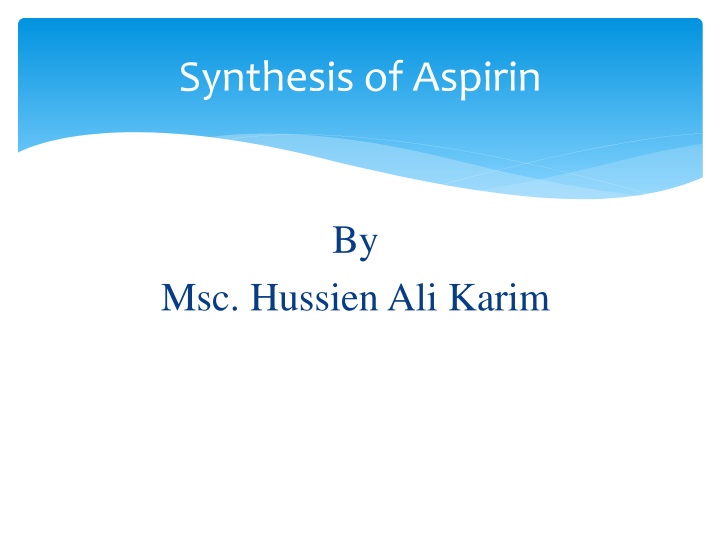
Aspirin Synthesis: Preparation, Stability, Mechanism & Notes
Learn about the synthesis of aspirin, including its characteristics, stability, mechanisms of reaction, and important notes for preparation. Understand the methods used and the reasons behind specific choices in the synthesis process.
Download Presentation

Please find below an Image/Link to download the presentation.
The content on the website is provided AS IS for your information and personal use only. It may not be sold, licensed, or shared on other websites without obtaining consent from the author. If you encounter any issues during the download, it is possible that the publisher has removed the file from their server.
You are allowed to download the files provided on this website for personal or commercial use, subject to the condition that they are used lawfully. All files are the property of their respective owners.
The content on the website is provided AS IS for your information and personal use only. It may not be sold, licensed, or shared on other websites without obtaining consent from the author.
E N D
Presentation Transcript
Synthesis of Aspirin By Msc. HussienAli Karim
Preparation of aspirin It is 2-acetyl salicylic acid or 2-acetoxy benzoic acid. Molecular formula is C9H8O4, M wt is 180.15. Characteristics: It is colorless crystals or white crystalline powder , odorless with slightly acid taste. Solubility: It is slightly soluble in water (1:300) at 25 , (1:100) at 37 more soluble in organic solvent, e.g. ether , ethanol, chloroform, .. etc.
Stability: In the form of crystals or powder, ASA is stable in dry air , but in contact with moisture, it degrades by hydrolysis to both SA and acetic acid (HAc), through base catalysis of the attack of water molecule by carboxylate anion. Mechanism:
Extensive decomposition of aspirin tablets is easily recognized by the odor of acetic acid , partially degraded aspirin tablets are sometimes seen with needles SA on their surface, a result of sublimation of SA. The melting point of ASA is not a reliable indicator of its purity because it partly decomposes on heating (137-143 ).
Synthesis of aspirin: Method 1:
Mechanism of reaction: 1- Protonation of the oxygen of carbonyl group:
Notes: Method 1 is used mostly because acetic anhydride is cheap, readily available, easily handled and doesn't form corrosive HCl gas. The reaction of acetylation is in the following order: Acetyl chloride > acetic anhydride > acetic acid On the other hand, acetylation of SA using acetyl chloride is very vigorous and will produce HCl gas which is corrosive to the respiratory tract. In this method, pyridine base is used because the unshared pair of electrons on the N will react with HCl and form pyridine chloride. On the other hand , pyridine base is teratogenic agent and air pollutant; therefore, we avoid this method of preparation.
Procedure : 1- Place 0.5g of SA into a dry small flask. 2- Add 2 ml of acetic acid . 3- Add 1-2drops of conc. H2SO4 , cautiously. 4- Put on heater stirrer with stirring until SA crystals get into solution. 5- Cool , white crystals of aspirin will appear. 6- Add little water then filter.
Notes: 1- If crystals of ASA remain in the reaction flask, use a little filtrate to wash them into the funnel. 2- Acetic anhydride ( an effective acetylating agent ) will be used to convert SA to ASA and to serve as a solvent for the reaction. 3- If crystals of ASA didn't appear after cooling , water is added to destroy the excess acetic anhydride ( converting it to water soluble acetic acid ). 4- Acetic acid is not added because it enhances the hydrolysis of ASA . The same is in case of adding excess conc. H2SO4 .
Calculation of % of yield: Calculation of % of yield: 1 mol S.A. 1 mol ASA 1g/138 = X/180 x= 1.3 g Hence, Theoretical yield of ASA = 1.3g Actual Practical yield =Y g ????????? ?? ?? ??????? ? ????????? ?? % ????? = 100 =Y/ 1.3 100 = Z %



















